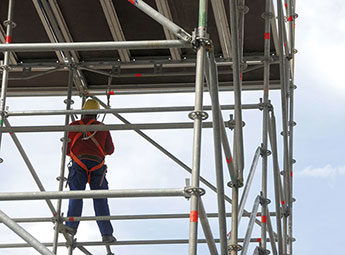Temporary structure, permanent safety
Help keep employees safe during all stages of scaffolding work

Struck-bys and material handling
Workers on all levels of a scaffold, as well as those on the ground, are exposed to possible falling objects, according to Palmer. Although workers on lower levels of a scaffold have overhead protection – the scaffold planks above them – that does not mean they are safe from falling objects.
Amedee suggested workers learn to “stay out of that line of fire” while on or around scaffolds. Employees can become injured by falling or dropped objects whenever they lean or reach outside the scaffold structure.
However, that is not the only way a worker can be injured. When an object – particularly a tool – drops from a scaffold, it may collide with other objects or part of the scaffold itself, and its path may change direction.
“A few of us call this the pinball effect,” Amedee said. “It kind of bounces around. You really don’t know where it’s going to go.”
Depending on the size or dimensions of the object and how it falls or bounces, workers as far as 30 horizontal feet away could be struck. Even people under the decking of a scaffold could be at risk. To prevent objects from falling, ensure toeboards are in place. When tools or equipment are piled higher than the top of a toeboard, OSHA requires paneling or a screen extending up to the guardrail to stop objects from falling.
Although not an OSHA requirement, using nets and tethered tools is considered a best practice for preventing falling equipment, Amedee said. Additionally, keeping a clean workspace is necessary so workers do not inadvertently knock a tool or building material off the scaffold. A clean workspace also minimizes the risk of a tripping hazard, Palmer said.
Similar to struck-bys and drops, basic material handling is important while working on a scaffold. Improper handling of materials can lead to ergonomics-related injuries, Palmer warned, so workers should be familiar with proper lifting techniques.
Scaffold erectors have to move large, bulky pieces of material, so a good grip in the center of the material should be used, Palmer said. Hands should be spread apart for maximum control. When moving very large pieces of material, co-workers should help.
Many employers are considering the use of mechanical devices to haul equipment up and down a scaffold instead of the old daisy chain method, in which erectors form a line and pass material to each other. However, Amedee cautioned that workers can be injured even if using mechanical lift devices. When hauling equipment, areas should be barricaded to keep people away, Amedee said.
Additional hazards
Falls and struck-bys are the biggest hazards on and around a scaffold, but they are not the only ones.
On higher elevated scaffolds, wind can be a serious issue. OSHA requires workers to use a personal fall arrest system in addition to the guardrail, or install a wind screen, in high-wind situations. Although the agency does not define a specific wind speed limit, Palmer suggested 25 mph.
Wind also can cause workers to drop large objects from a scaffold. “The wind might just take it right out of your hands,” Palmer said.
Being on a scaffold brings workers closer to overhead power lines. Because of the risk of electrical injuries, OSHA requires 10 feet of clearance between power lines and everything on the scaffold. This includes all workers and materials.
For example: If a scaffold decking is 20 feet away from power lines and a 6-foot-tall worker holds a piece of material 10 feet long above his head, this scaffold would not ?be in compliance because the material would be about 4 feet away from the power lines – less than the required clearance.
All workers should know the load limit of the scaffold they are working on. This may require a bit of math on the worker’s part – scaffold platforms come in three categories of uniform loading, and each category has a weight limit per square foot. Workers will need to know their weight, as well as the weight of all the material and tools they plan on bringing onto the scaffold.
Some workers – such as bricklayers or masons – commonly overload the scaffold by bringing up a lot of material all at one time, according to Amedee. When workers overload the scaffold and exceed its weight limit, the scaffold has the potential to collapse.
Instead, Amedee said, workers should stay under the scaffold’s weight limit and retrieve supplies as needed.
Attitude
Perhaps above all else, workers on scaffolds need to keep in mind where they are – on a temporary, elevated platform with exposure to a number of hazards. Palmer recommended workers on scaffolding be extra cautious by moving a bit slower and being more aware of the various width and length constraints of the structure.
“They need to understand they’re not just working on the ground. They’re at elevation,” Palmer said. “Even if the scaffold is completed and all the guardrails are installed, they need to have some respect for the potential hazard of working at heights.”
Post a comment to this article
Safety+Health welcomes comments that promote respectful dialogue. Please stay on topic. Comments that contain personal attacks, profanity or abusive language – or those aggressively promoting products or services – will be removed. We reserve the right to determine which comments violate our comment policy. (Anonymous comments are welcome; merely skip the “name” field in the comment box. An email address is required but will not be included with your comment.)


